Maryland Fishing Report – August 14
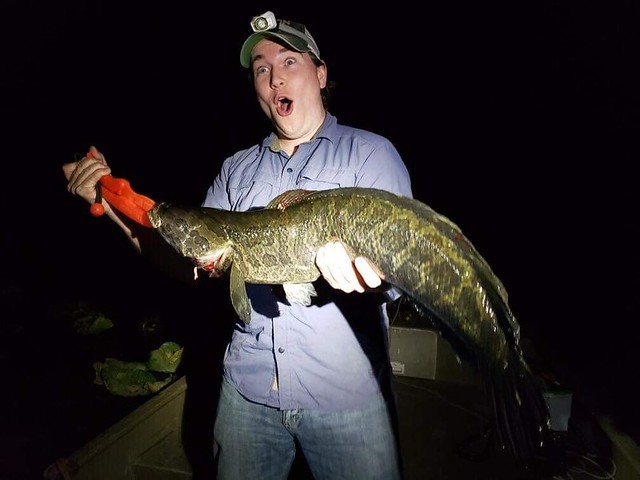
Photo by Michael Carr
No matter how seasoned one is as a fishermen, catching a noteworthy fish brings out excitement that is too often suppressed deep within us. Our daily trials can take a toll on our sense of childlike fun. This photo made me smile and caused me to relive a few moments that I shared with friends when catching a truly exciting fish. Fishing brings joy, no matter how the fish is taken or if it is an invasive fish that carries the distinctive name of northern snakehead.
This fishing forecast for the third week in August will be a repeat of the last several weeks. Anglers will see very warm water, low winds, and a chance for an afternoon thunderstorm Wednesday and Thursday. The same general fishing pattern will continue. Focus on areas with adequate oxygen and the coolest water just above the “Do not fish below this depth.” Recent water monitoring indicates that most of these deeper, cool main bay areas with adequate oxygen are registering a warm 81 degrees. The other way to find cooler water is to fish the shallows near prime daytime areas at first light or after sunset when surface water temperatures can be several degrees cooler.
Bay surface salinities are still below normal for this time of year but are improving slightly. In most shallower bay waters, anglers will find adequate oxygen from the surface down to about 20 feet for bay gamefish. Exceptions are the Magothy, West and South rivers, which have adequate oxygen down to only 10 feet or less. To avoid low oxygen conditions in the deep channel waters from the Bay Bridge down to the state line and the lower Potomac River, avoid fishing deeper than about 23 feet. However, at the Bay Bridge and the Potomac River, from Colonial Beach downriver to Tall Timbers, avoid fishing below 15 feet. In these areas, windy conditions may force low-oxygen water into areas of shallow water. For oxygen forecasts, see VIMS Depth to 3 mg/l. To see oxygen levels by depth, see the Do not fish below this depth map. Expect poor water clarity due to algal blooms from the Patapsco River down to Chesapeake Beach, the Choptank River, and the Colonial Beach area of the Potomac River.
As recorded at the real-time buoys, bay water temperatures continue to be very warm. For the mid, upper, and lower bay, Choptank River, and lower Potomac River, water temperatures are in the low to middle 80s. Water temperatures at Little Falls have risen to the upper 80s. To see water temperature by depth, check the Water temperature by Depth map. Expect normal flows from most Maryland rivers and streams this week. There will be above average tidal currents Sunday through Tuesday as a result of the upcoming full moon on Thursday, August 15.
For the full weekly fishing conditions summary and more detailed and up-to-date fishing conditions in your area of the bay, be sure to check out Click Before You Cast. You can now get regular updates on Maryland’s waters and the creatures that call them home sent to your inbox with our new Eyes on the Bay newsletter. Sign up online.
Striped Bass Summer Fishing Advisory Forecast:
Red: Air temperatures are forecast at 95 degrees or higher. Anglers are encouraged not to fish for striped bass after 10 a.m. and should target other species of fish.
Yellow: Air temperatures are forecast at 90-94 degrees. Anglers should use extreme care when fishing for striped bass; fish should be kept in the water when caught and released on these days.
Green: Fishing conditions are normal. Proper catch-and-release practices are encouraged.
More information about this awareness campaign can be found on the Striped Bass Fishing Advisory Forecast webpage.

Eight-year-old Devon Degarmo is all smiles with his first ever striped bass. Photo by Capt. Andy Wayson.
At the northern extreme of the upper bay, fishing for striped bass has been very slow around the edges of the Susquehanna Flats and the lower Susquehanna River. The Conowingo Dam is in a daily power generation phase during the day and there has been a little striped bass action in the dam pool at dawn. Casting topwater lures and crankbaits has been the favored way to fish.
Farther down the bay there has been some striped bass action near the Key Bridge piers and nearby old pier structures in the early morning hours on a good running tide. Live lining spot, white perch, and live eels has been popular. Drifting cut bait or jigging can also work.
Striped bass are also being found holding in relatively shallow waters of 20 feet or less near Swan, Love, and Podickory points, the Bay Bridge piers, and the sewer pipe. The striped bass are holding in these areas due to extreme oxygen deficits in deeper waters; meanwhile, the extreme surface temperatures are taking a toll on released fish.
The numbers of larger striped bass that were being seen at these locations in June appear to have dwindled significantly and as a result there is a high number of sub-legal discards at these locations for those live-lining spot or white perch or drifting cut bait and soft crab baits. This all adds up to a bad situation for released striped bass that are expiring from heat-related physical stress. Anglers are urged to either forego fishing for striped bass altogether at this time or to try to limit catch and release. Using sturdy tackle, keeping fight time to a minimum, and releasing fish quickly in the water can help.
Anglers are reminded that they must use circle hooks when live-lining. Check our website and video for more information on circle hooks and careful release. It is not uncommon for striped bass to curtail feeding by mid-morning at some of the above fishing sites due to extreme surface water temperatures. As a result, a fleet of boats fishing at the Bay Bridge anchor up to fish the bridge piers at night until the late hours. Anglers are reminded that regulations state that it is illegal to possess striped bass while fishing in the Chesapeake Bay or its tributaries from midnight to 5 a.m.
Jigging is a viable option wherever striped bass can be found suspended along channel edges, humps, or the Bay Bridge piers. The action tends to be a very early morning or late evening venture. Skirted jigs with soft plastics are favored and placing your favorite scent on can often work wonders. Trolling has been reported to be a slow pick as Spanish mackerel and bluefish have yet to make their way into the upper bay this week.
Fishing for white perch at shallower, hard-bottomed areas has been a great diversion for upper bay anglers. Some of the lumps off Tolchester, Belvidere Shoals, and similar knolls are worth checking out with a depth finder to find schools of white perch. The mouth of the Magothy, the west side of the Bay Bridge, and out in front of the Sandy Point State Park beach have also been holding white perch as well as large numbers of spot. Small pieces of bloodworm on a two- hook bottom rig will get you into the action.
Anglers looking for some light tackle action in the tidal rivers and creeks in the upper bay region are enjoying good fishing for white perch in the early mornings and late evenings. Shoreline structure such as fallen treetops, sunken wood, rocks, and docks are all good places to cast beetle spins, roadrunners, small spinnerbaits, or spinners. There are also plenty of channel catfish residing in the tidal rivers and creeks that can be caught on a variety of cut baits.
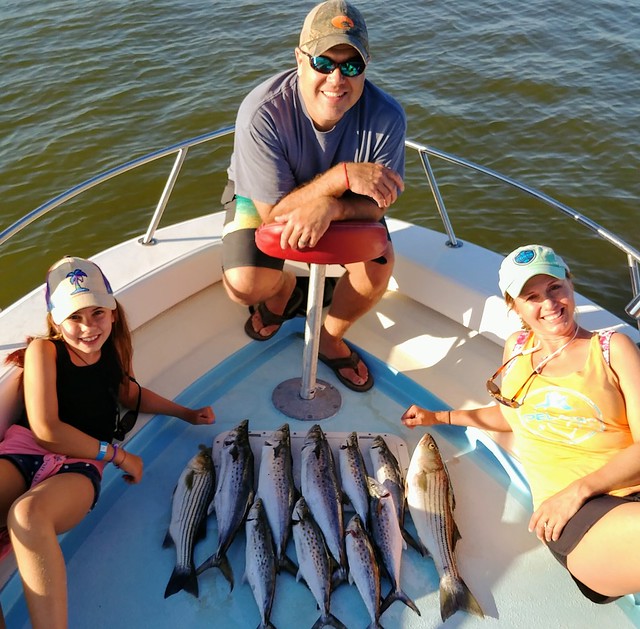
Dave Ziegler enjoyed a fun day of trolling with his wife Christina and daughter Grace. Photo courtesy of Dave Ziegler.
Those fishing in the middle bay region are enjoying the arrival of Spanish mackerel and bluefish, which are providing plenty of exciting fishing and a relief from the drudgery of live-lining for too few legal-sized striped bass. Spanish mackerel are being found along both sides of the shipping channel. Trolling with small spoons behind number one planers has been the ticket to this event. Small spoons in gold, silver, and chartreuse stripes have been popular and are tied to long leaders of mono or fluorocarbon from 12 feet to 18 feet. Some anglers are also using inline weights to vary their trolling spreads. One or two red or green hoses can also put some variety in a trolling spread and tend to be a favorite of bluefish.
Those wishing to fish for striped bass have been cozying up to Thomas Light or the outside edge of Hackett Point. Thomas Point tends to be the most popular location to live line spot or jig soft plastics. A high percentage of sub-legal throwbacks are being reported at these locations, causing warm water catch-and-release mortalities. A very early morning shallow water striped bass fishery is reported along the rocks at Poplar Island and other shoreline areas, but fishing is reported to be short-lived as the sun rises and there is a high amount of sub-legal throwbacks.
White perch fishing has been providing some wonderful fishing fun in a variety of locations this week. Some of the deeper live oyster bottom areas in the tidal rivers have been great places to catch white perch on a bottom rig. Those targeting white perch can take advantage of the large number of peeler crabs available this week for bait and save some money by not purchasing bloodworms. For those targeting spot in the same areas or on sandy shoals, bloodworms will be the number one bait.
Perhaps one of the most satisfying ways to fish for white perch is to cast small lures with ultra-light tackle along shoreline structure. This is a fun way to spend a summer morning or evening in a small boat, kayak, or canoe casting to docks, rocks, sunken wood, or fallen treetops. Beetle spins, small spinnerbaits, jigs, spinners, and roadrunners are generally the most popular lures to use. Fishing off a favorite dock with grass shrimp or pieces of bloodworm straight down near the pier bases is a great way to catch white perch, especially for our younger anglers. There are plenty of channel catfish in tidal rivers and creeks of the middle bay region and they can be caught on most cut baits.
The most popular type of fishing going on this week in the lower bay tends to be focusing on the plentiful Spanish mackerel and bluefish in the region. The mix of Spanish mackerel and bluefish are feeding on schools of bay anchovies. Most anglers are trolling small spoons behind planers or inline weights, but others are enjoying casting small lures to breaking fish. Small Clark and Drone spoons are being pulled behind number one planers with long mono or fluorocarbon leaders; inline weights are also being used to cover shallower segments of the water column. Green and red hoses are often part of a trolling spread to entice bluefish and possibly a wandering cobia.
When breaking fish are encountered during this time of the summer in the lower bay, it is often a good idea to watch for large red drum lurking underneath the surface action. They show up well on depth finder and using large soft plastic jigs is a good way to catch them, as is trolling large spoons. Treat them with care when releasing. Sight fishing for cobia continues to be a draw in the area from the Middle Grounds to the Target Ship for those that can get up high enough to spot them. Casting live eels, spot, or large soft plastic jigs to them can often entice them to strike. A total length of 40 inches is required; one per person per day but no more than three cobia per boat per day; the season runs to September 30.
Those looking for some striped bass action will find it along the channel edge in the lower Potomac River from Piney Point to St. Georges Island. Live-lining spot is the most popular way to catch them. Striped bass may be found suspended along channel edges in the lower Patuxent River or near Cedar Point and Point Lookout. There is also some limited early morning and late evening striped bass action for those casting swimbaits, crankbaits, and topwater lures along shoreline structure.
Anyone fishing the shorelines of the lower Patuxent River near the Naval Air Station should be familiar with the following regulations. There is a 75 yard safety zone off the shoreline that folks in boats cannot enter, and if you’re fishing from shore in the base you need to get the permit.
Bottom fishing for large spot mixed with white perch has been a wonderful way to enjoy some fun fishing in the Tangier Sound area or the lower Patuxent River. Pieces of bloodworm on a simple bottom rig is the favored way to catch large spot and white perch. In some areas, small sea trout, speckled trout, kingfish, and small croakers can be part of the mix. This is a wonderful opportunity for some family fun with younger anglers and those who don’t fish often. Hard bottom in depths of 8 feet to 16 feet is the place to fish. Some nice flounder are being caught along channel edges in the Pocomoke Sound area.
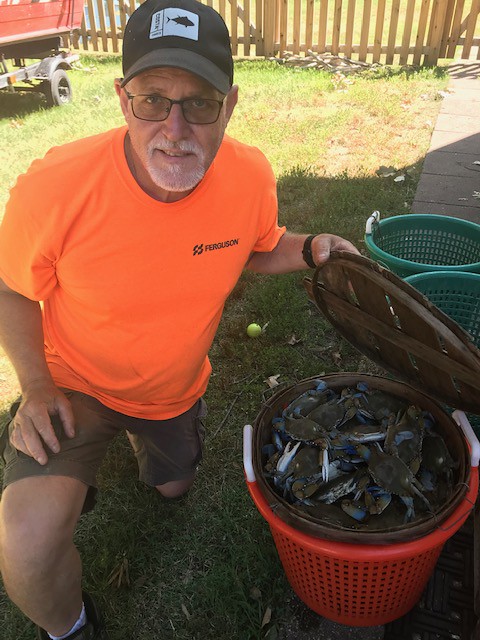
Jim Livingston shows us a peek at a nice bushel of Rhode River crabs. Photo courtesy of Jim Livingston.
Recreational crabbing continues to improve as more and larger crabs enter the fishery. Crabbing has not been a cakewalk by any means but those that put their time in and are flexible in regards to moving until they find good crabs are doing well. The tidal rivers of the middle and lower bay regions offer the best chance of success. Some of the large and heavy crabs being caught are absolutely outstanding! There was a large peeler run last week so there will be quite a few male crabs that may measure just over 5 1/4 inches. These crabs but will be light, so go for the 6 inch to 7 inch crabs, which are mostly being found in waters deeper than 8 feet. The shallower waters are reported to be holding lots of smaller crabs and if you’re using razor clams you will be out of bait fairly quickly. Chicken necks hold up better and are an easy choice for most recreational crabbers.
Many of the trout management waters in the western and central region that are set aside for fly fishing are providing some good summertime fishing opportunities, but anglers may see lower flows in some waters. Trout fishing in skinny water offers new challenges to the fly fisherman or someone using ultra-light spinning tackle where allowed. Trout will be wary which makes the quest to fool them all the more fun. Using 10 foot to 13 foot leaders tapering down to 6x or 7x is a good idea, as is keeping a low profile on your approach. Ants and beetles can often be the best selection during the heat of the day but hoppers and inchworms are also good bets. In the early morning hours a #16 or #18 tan caddis can often be a good choice. Streamers are always a fun and effective way to fish for browns.
Largemouth bass are feeding mostly at night during this hot weather but can be caught early in the morning as they linger in the shallower areas where they have been feeding. On the flip side, by late evening or dusk, they can be found moving towards those shallower areas. Largemouth bass are usually near grass or plants such as lily pads or spatterdock. In the tidal rivers, playing the tide can offer some advantage as fish will tend to move into those areas on a flood tide and retreat on an ebbing tide.
Topwater lures such as buzzbaits, chatterbaits, or weedless frogs are good choices for working grass. Spinnerbaits and lipless crankbaits can work well along the edges. During the day, largemouth bass will retreat to deeper water to find cool shade. Shady areas may also be found under thick grass mats, docks, fallen treetops, sunken wood, and small feeder creek mouths. Dropping weighted stick worms or soft plastics down through the thick grass to reach the bass hunkered down underneath is a good trick. Flipping stick worms or soft plastics under docks or wood is a good tactic for bass holding in shade.
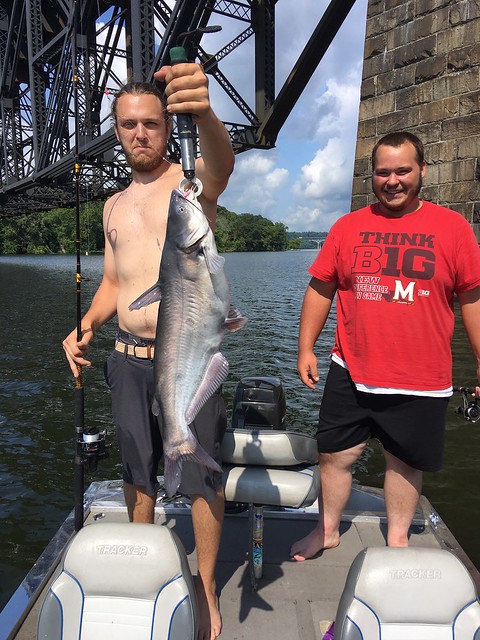
These two guys look like they’re having fun catching blue catfish in the lower Susquehanna River. Photo by Paul Martin.
Fishing small ponds and lakes for bluegills and other sunfish can offer plenty of summertime fun, especially on a quiet summer evening. It is a perfect set-up for our younger anglers to fish with a bobber and baits such as worms or crickets. Breaking out a light weight fly rod and some small rubber- legged poppers or flies such as foam ants and beetles can make the most seasoned fisherman smile. Few things are more exciting than a surface strike and explosion.
The tidal rivers and unfortunately some impoundments in Maryland are holding northern snakeheads, which can provide plenty of summertime fishing excitement. The tidal creeks and the main stem of the Potomac River hold large populations of northern snakeheads as do the tidal waters of the lower Eastern Shore. They will also be found in virtually every tidal river and creek throughout the Chesapeake Bay water system. Casting buzzbaits and plastic frogs over shallow grass tends to be a favored way to entice them to strike. If you see a snakehead fingerling swarm bubbling near the surface the parent will not be far away and can often be enticed to strike a lure that is menacing their brood.
The various catfish species that we now have in Maryland offer plenty of fun and rewarding summer fishing. Channel catfish can be found in most of the tidal rivers and creeks feeding into the Chesapeake Bay. Blue catfish are extremely abundant in the tidal Potomac with the tidal Patuxent and Nanticoke rivers quickly catching up. Blue catfish are also very common in the lower Susquehanna River. Flathead catfish are common in the Conowingo Dam pool and lower Susquehanna and are now being found in the upper Potomac River. All can be caught on fresh-cut bait.
Atlantic Ocean and Coastal Bays
The White Marlin Open is behind us and Ocean City waterways are returning to a more steady summer pace. Surf fishing is mostly centered on catching kingfish and small bluefish with a mix of spot, croaker, and flounder rounding things out. Due to the intense summer heat, the best fishing for kingfish has been in the mornings and evenings, with pieces of bloodworms or Fishbites the favored baits. The bluefish are being caught on finger mullet or cut spot.
At the inlet and Route 50 Bridge area, bluefish continue to move in and out of the inlet with the tides. The dredging operations have caused some disturbance but will be done soon. Sheepshead and triggerfish are being caught at the South Jetty on sand fleas. A few striped bass over 28 inches have also been caught by drifting live spot or eels.
In the channels near the inlet and the back bay areas, flounder fishing has been very good. The largest flounder are being caught on white Gulp baits, live spot, or live menhaden. The traditional baits of minnows and squid continue to catch the lion’s share of keeper size flounder, but there is a fair percentage of throwbacks with the smaller traditional baits.
Perhaps one of the most exciting fishing opportunities for anyone venturing out to the inlet is the action taking place close to shore on shoal areas such as Little Gull, Fenwick, and Great Gull shoals. Some “smoker” sized king mackerel have been caught recently along with large cobia, Spanish mackerel, and bluefish.
The sea bass fishery is having a good week with the sea bass in the mood to bite. A mix of triggerfish and flounder help fill out the bill also. Boats trolling near the 30 Fathom Lumps have been catching chicken dolphin, Atlantic bonito, and Bluefin tuna.
Fishing for white marlin has been good at the canyons along with a mix of gaffer dolphin, wahoo, and blue marlin. Yellowfin tuna, a few bluefins, and the occasional bigeye tuna are also being caught at the canyons. A big swordfish was also brought in this week to the docks, a fine catch.
“So if escapism is a reason for angling-then the escape is to reality. The sense of freedom that we enjoy in the outdoors is, after all, a normal reaction to a more rational environment. ” — A.J. McClane
Maryland Fishing Report is written and compiled by Keith Lockwood, Maryland Department of Natural Resources fisheries biologist.
Click Before You Cast is written by Tidewater Ecosystem Assessment Director Tom Parham.
This report is now available on your Amazon Echo device — just ask Alexa to “open Maryland Fishing Report.”



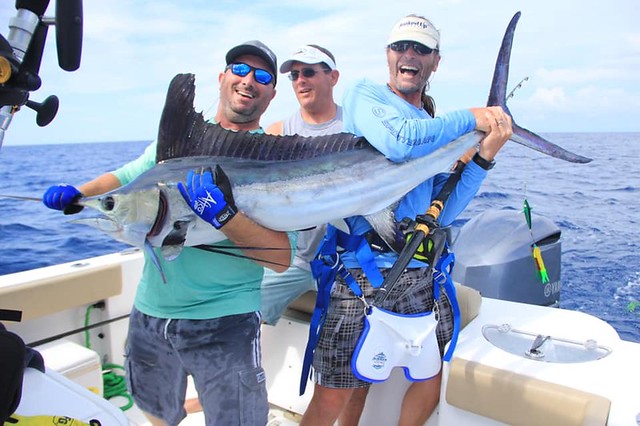
 1-888-373-7888
1-888-373-7888 233733
233733